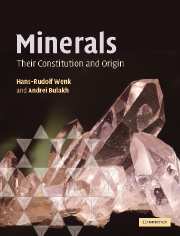Book contents
- Frontmatter
- Contents
- Preface
- Acknowledgments
- Figure credits
- Part I Structural features of minerals
- 1 Subject and history of mineralogy
- 2 Elements, bonding, simple structures, and ionic radii
- 3 The concept of a lattice and description of crystal structures
- 4 Macroscopic symmetries : crystal morphology
- 5 Crystal growth and aggregation
- 6 Isomorphism, polymorphism, and crystalline defects
- Part II Physical investigation of minerals
- Part III Variety of minerals and mineral-forming processes
- Part IV A systematic look at mineral groups
- Part V Applied mineralogy
- Appendices
- Glossary
- References
- Index
- Plate section
- References
2 - Elements, bonding, simple structures, and ionic radii
from Part I - Structural features of minerals
- Frontmatter
- Contents
- Preface
- Acknowledgments
- Figure credits
- Part I Structural features of minerals
- 1 Subject and history of mineralogy
- 2 Elements, bonding, simple structures, and ionic radii
- 3 The concept of a lattice and description of crystal structures
- 4 Macroscopic symmetries : crystal morphology
- 5 Crystal growth and aggregation
- 6 Isomorphism, polymorphism, and crystalline defects
- Part II Physical investigation of minerals
- Part III Variety of minerals and mineral-forming processes
- Part IV A systematic look at mineral groups
- Part V Applied mineralogy
- Appendices
- Glossary
- References
- Index
- Plate section
- References
Summary
Chemical elements
Many mineral properties are closely related to the underlying chemical properties of constituent atoms and molecules. Let us start, therefore, by reviewing some fundamental chemistry. The basic building unit of a crystal is the atom. Atoms are composed of a very small nucleus containing positively charged protons and neutral neutrons. Negatively charged electrons, distributed over a much larger volume, surround this nucleus. In the absence of an electric field, an isolated atom has a spherical shape with a diameter of 1–2 Å (1 ångström = 10-10 meter or 10 nanometers (nm)) (Figure 2.1a). Electrons are responsible mainly for the chemical behavior of atoms and for bonding, which combines atoms to form larger molecules and crystals. Depending on the number of protons, atoms form different elements with distinct chemical properties. At present 109 elements are known and new ones are being discovered. The atomic number of an element is the number of protons found in an atom of that element. It is also equal to the number of electrons when the atom is in a neutral state. Elements are represented in the Periodic Table (Figure 2.2) by placement into rows and columns that arrange atoms with specific electronic configurations. In this table the full names of elements, as well as their abbreviated symbols are given.
In the simplified view of the atomic structure formulated by Niels Bohr, electrons are arranged in shells, labeled K, L, M, etc. (Figure 2.1b).
Information
- Type
- Chapter
- Information
- MineralsTheir Constitution and Origin, pp. 12 - 31Publisher: Cambridge University PressPrint publication year: 2004
